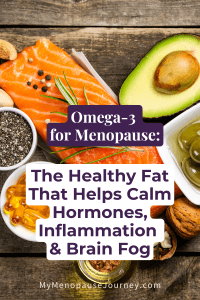Omega-3 for menopause is something I wish I had known about when I first hit perimenopause. Back then, I had no idea how much inflammation was running the show inside my body.
If your body is a house, inflammation is like a fire in the walls — not big enough to burn the place down immediately, but hot enough to cause damage over time. And I was living with that fire without even knowing it.
I was waking up puffy. My joints ached at lunchtime. I couldn’t finish a thought without losing the thread. And my mood? One minute I was sharp, the next I was flat.
Everything felt louder. Heavier. Unpredictable.
And here’s the kicker — a lot of that “fire” comes from the wrong kinds of oils and fats hiding in everyday foods. Processed snacks, seed oils, fried takeaways, even so-called “healthy” spreads… they don’t just sit quietly in your body. They fuel inflammation and make hormone chaos worse.
That’s why bringing in the right fat — like omega-3 — can be such a game-changer.
At first, I thought it was just the hormonal drop. And yes — low progesterone and estrogen shifts are real. But what I didn’t know then was how much my fat balance was fueling the “fire,” the symptoms triggered by inflammation.
And here’s the truth most of us never learned: hormones are made from fat.
I’ll say that again… hormones are made from fat. So, if you’re eating the wrong type — or too much of one kind — your body can’t make, regulate, or calm those hormones properly.
Keep reading and dive deep into two of the most powerful types of fat: omega-3 and omega-6!


- Omega-3 vs Omega-6: The Ratio That Shapes Hormone Balance in Menopause
- What Omega-3 Did for Me…
- How Omega-3 for Menopause Supports Hormone Balance
- Best Omega-3 Sources (and What to Avoid)
- Best Omega-6 Sources (and What to Avoid)
- How to Gently Shift the Ratio
- Final Thoughts: One Piece of the Puzzle
- FAQ: Omega-3 for Menopause
Omega-3 vs Omega-6: The Ratio That Shapes Hormone Balance in Menopause
Two kinds of fats show up over and over when we talk about inflammation and hormones: Omega-3 and Omega-6.
Omega-3 is your calming fat. It cools inflammation, sharpens the brain, and supports hormone balance in menopause by helping your body process estrogen and progesterone more smoothly.
Omega-6, in small amounts, helps with immunity and energy. But when it dominates your diet — which is usually the case for many — it becomes a chaos starter. It stokes inflammation and throws your hormones off.
Here’s where the ratio comes in. Ideally, our bodies thrive on a balance close to 2:1 or 4:1 (omega-6 to omega-3). But today, most women are living at 15:1, even 25:1. That’s like trying to fight a fire with a single drop of water. When omega-6 overwhelms omega-3, inflammation skyrockets and menopause symptoms feel so much worse.
This imbalance can then make everything feel worse in midlife…
- Hot flashes become more intense.
- Skin feels drier and more reactive.
- Joints swell and belly fat increases.
- Mood swings intensify.
- Brain fog turns into full-on mental gridlock.
This imbalance can then make everything feel worse in midlife…
What Omega-3 Did for Me…
When I started adding more omega-3 for menopause support — without overcomplicating it — I didn’t expect much.
But over time, I noticed:
- I wasn’t as puffy when I woke up
- My thinking was clearer
- My joints didn’t ache so much
- I wasn’t reacting to every little stressor
- And my sleep? Finally deeper again.
It didn’t fix my hormones overnight. But it gave my body a foundation to stabilize — and that made everything else I was doing (sleep, blood sugar balance, stress recovery) work better!
How Omega-3 for Menopause Supports Hormone Balance
Here’s how omega-3 and hormone balance go hand in hand during perimenopause and menopause:
- Reduces inflammation linked to joint pain, bloating and weight gain
- Supports estrogen and progesterone regulation, helping ease hormone swings
- Boosts brain function, improving memory, focus and clarity
- Calms mood, reducing the intensity of anxiety and irritability
- Improves sleep, by stabilizing your nervous system and blood sugar
- Helps reduce hot flashes and vaginal dryness in some women
It’s not a miracle pill. But it’s one of those quiet supports that makes everything else more manageable.
Best Omega-3 Sources (and What to Avoid)
If you’re wondering about the best omega-3 for menopause, you don’t need a cupboard full of supplements. Just a few quality options!
✅ Best Food Sources
- Wild-caught salmon, sardines, herring, mackerel
- Chia seeds, flaxseeds, hemp seeds (ground for better absorption)
- Pasture-raised omega-3 eggs
- Algae oil (great vegan source of DHA)
✅ Best Omega-3 Supplements for Women
- Krill oil – more absorbable, less prone to oxidation
- Fish oil – purified and tested for mercury
- Algae oil – if you’re plant-based or sensitive to fish
⚠️ What to Watch Out For
- Seed oils (soybean, corn, sunflower, canola) — high in omega-6
- Over-processed “healthy” snacks with hidden inflammatory oils
- Multi-omega blends with unclear EPA/DHA amounts
Best Omega-6 Sources (and What to Avoid)
You don’t need to fear omega-6 — just choose it wisely. Remember, it’s about balance, not elimination.
✅ Best Food Sources
- Nuts like raw walnuts, almonds, pistachios – whole, minimally processed
- Pumpkin seeds, sesame seeds, sunflower seeds (prefer raw or lightly toasted)
- Cold-pressed oils: evening primrose oil, borage oil, hempseed oil
- Pasture-raised meats and eggs (better omega-6 to omega-3 ratio)
✅ Best Omega-6 Supplements (When Needed)
- Evening primrose oil – supportive for women’s hormone balance
- Borage oil – rich in GLA (gamma-linolenic acid)
- Hempseed oil – balanced omega-6 to omega-3 ratio
⚠️ What to Watch Out For
- Refined seed oils (soybean, corn, sunflower, canola) – highly processed, pro-inflammatory in excess
- Fried foods, fast food, and processed snacks – often cooked in unstable omega-6-rich oils
- Shelf-stable baked goods – may contain hydrogenated or oxidized fats
How to Gently Shift the Ratio
You don’t need to overhaul your diet or track every gram.
Just start moving in a better direction:
- Eat fatty fish 2–3 times a week
- Add flax, chia, or hemp to your meals
- Use olive oil, avocado oil, or ghee for cooking
- Swap your supplement to a clean, effective omega-3
- Avoid foods with industrial seed oils
- Be kind to your body when it’s asking for rest
The goal isn’t perfect. The goal is better. More supportive. Less inflamed.
Final Thoughts: One Piece of the Puzzle
If you’re foggy, fatigued, puffy or overwhelmed — it’s not all in your head.
And it’s not all about hormones either.
Sometimes, it’s the raw materials your body’s trying to work with.
Omega-3 for menopause won’t fix everything. But it can help calm the noise — in your joints, your brain, your belly, and your moods.
So, don’t ignore healthy fats! Especially if your body’s been whispering for help.
This might be one small, loving shift — the kind that helps everything else work just a little bit better.
FAQ: Omega-3 for Menopause
What is the best omega-3 for menopause?
The best omega-3 sources for menopause are fatty fish like salmon, sardines, and mackerel, along with clean supplements such as krill oil, fish oil, or algae oil if you’re plant-based. These provide EPA and DHA, the forms your body uses most easily.
How does omega-3 help with menopause symptoms?
Omega-3 supports hormone balance, reduces inflammation, and helps calm symptoms like hot flashes, brain fog, mood swings, and joint pain. It won’t fix everything, but it creates a steadier foundation so your body can cope better.
What is the right omega-3 to omega-6 ratio for menopause?
Ideally, women do best with a ratio close to 2:1 or 4:1 (omega-6 to omega-3). Today, most diets are 15:1 or higher, which fuels inflammation and makes menopause symptoms more intense. Shifting the balance toward more omega-3 helps calm things down.
Can omega-3 reduce hot flashes?
For some women, yes. Omega-3 has been shown to ease hot flashes and night sweats by supporting estrogen balance and calming the nervous system. Results vary, but many notice fewer or less intense hot flashes after adding more omega-3.
Should I take an omega-3 supplement or just eat food sources?
Food is always a great start — fatty fish, chia, flax, and hemp seeds all help. But most women don’t get enough from diet alone, so a high-quality omega-3 supplement can be a smart, supportive choice in midlife.
References:
pubmed.ncbi.nlm.nih.gov/12442909/
sciencedirect.com/science/article/pii/S2666149724000379
pmc.ncbi.nlm.nih.gov/articles/PMC8504498/
sciencedirect.com/science/article/abs/pii/S0753332202002536
my.clevelandclinic.org/health/articles/17290-omega-3-fatty-acids
mdpi.com/2072-6643/13/7/2421


Gita is the founder of My Menopause Journey. Since 2014, she has been supporting midlife women by sharing hard-earned learnings from her own experience. To advance her knowledge, Gita puts a lot of her time and effort into understanding the broad spectrum of women’s health. She immerses in extensive research about the physical, mental and emotional aspects of menopause. Gita believes in the life-changing power of healthy, holistic living — this is where she anchors her message to all women. Learn more about her marvelous mission in About us - My Menopause Journey.



